What is a Retaining Wall?
In technology, a retaining wall could be a significant reasonable construction. The first function of the wall is to keep the earth or other materials vertical or near-vertical. This wall is commonly used in various applications, including road, railway, bridge, irrigation engineering, land reclamation, and coastal engineering. The vertical or inclined stem is solid monolithically joined to a base block. These are considered suitable up to a height of 6 meters.
Retaining walls are solid wall structures that support soil laterally to keep the ground surface at distinct elevations on both sides of the building. If a retaining wall is not present, the soil at a higher elevation will tend to sink until it reaches its natural, stable shape.
The function of Retaining Wall:
- This wall keeps the soil or other material from shifting in situations where the elevation changes abruptly.
- Earth retaining structures keep the earth in place and preserve the ground surface height difference.
- Other externally exerted loads are safely transmitted to a foundation by retaining structures designed to withstand the soils or backfill.
Types of Retaining Wall:
Retaining walls are complete walls that serve as landscape elements. Others are components of the infrastructure of a building, a road, or a bridge. They’re usually made of strong in-place concrete, masonry block walls, or substantial wood. The types of retaining walls are as follows:
1 Gravity Retaining Wall:
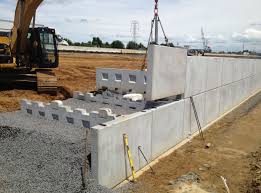
Fig 1: Gravity Retaining Wall
Courtesy: roadsbridges.com
Only the weight of the gravity retaining wall can withstand lateral earth pressure. Gravity retaining walls are often huge because they require a large gravity load to counteract horizontal soil pressure. When building a gravity retaining wall, sliding, overturning, and bearing forces must be considered. It can be made of various materials, including stone, concrete, and masonry units. Gravity retaining walls, such as crib retaining walls and gabion retaining walls, are becoming more popular in recent years.
2. Reinforced Retaining Wall:
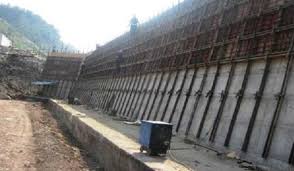
Fig 2: Reinforced Retaining Wall
Courtesy: theconstructor.org
The use of reinforcement to strengthen the soil in this retaining wall has been recognized for years. Before road building, straws were employed to strengthen unburned bricks, while fascine mattresses bolster soft soil deposits.
The basic phenomenon at work in reinforced earth walls is that if the lengths of a material capable of sustaining stress are embedded inside it in the desired direction, a mass of soil can be given tensile strength. Many geotechnical applications have made use of reinforced earth.
3. Cantilever Retaining Wall:
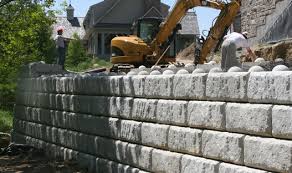
Fig 3: Cantilever Retaining Wall
Courtesy: rccconstruction.blogspot.com
The stem and base slab are two components of the cantilever retaining wall. Reinforced concrete, prestressed concrete, or precast concrete can construct a cantilever retaining wall. Cantilever retaining walls are often built of concrete that has been prepared on-site by forming formwork. As a cantilever retaining wall, a precast retaining wall is employed.
Part of the base slab is put below the backfill material in this retaining wall. The heel is the vertical part, while the toe is the other vertical part. A cantilever retaining wall is normally very cost-effective up to 10 meters.
Compared to a gravity retaining wall, this retaining wall uses less concrete. However, it is meticulously built to account for various aspects in its ideal state. The cantilever retaining wall design includes sliding, uplift pressure, and soil bearing pressure.
4. Counterfort Retaining Wall:
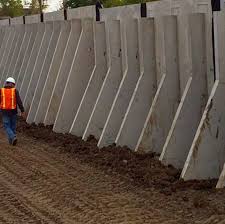
Fig 4: Counterfort Retaining Wall
Courtesy: civiclick.com
Counterfort retaining walls are similar to cantilever retaining walls, except they include thin vertical concrete webs at regular intervals along the rear of the wall, known as counterfort. The counterfort connects the slab and the base, and their purpose is to lessen the soil’s bending moments and shear stresses on the wall. The extra concrete increases the wall’s weight, a secondary impact of these webs. It can be prefabricated or built on the spot.
5. Buttress Retaining Wall:
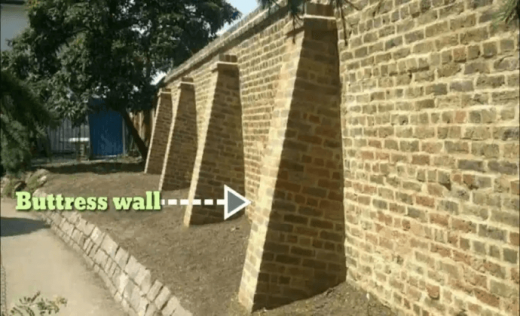
Fig 5: Buttress Retaining Wall
Courtesy: civiconcept.com
A type of counterfort wall is a buttress wall. Retaining walls of this sort are constructed on the face of the wall rather than within the backfill. Buttress walls are not very popular due to the exposed buttressed shape on the outside, which takes up space and detracts from the overall aesthetic.
6. Gabion Retaining Wall:
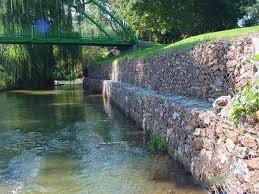
Fig 6: Gabion Retaining Wall
Courtesy: gabionmattress.org
This retaining wall is constructed of stone-filled gabions tightly attached to the wire. Rather than being vertical, gabion walls are frequently slanted. Galvanized steel wire is commonly used in this retaining wall. The wire coated with PVC or stainless steel can also be utilized.
Gabion Retaining Walls can be used to prevent erosion on river banks, beaches, highways, and other sloped areas. Gabion walls give the landscape a streamlined appearance.
7. Crib Retaining Wall:
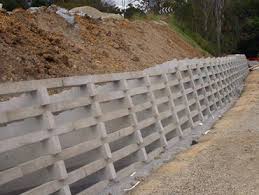
Fig 7: Crib Retaining Wall
Courtesy: architechtureanddesign,com.au
Gravity walls are similar to these types of retaining walls. Individual interconnecting boxes made of precast concrete or wood make up the structure. The boxes are filled with crushed stone or coarse granular materials to create a free-draining structure. Timber retaining walls and reinforced precast retaining walls are two common types of crib retaining walls. It is appropriate for sustaining planter areas but unsuitable for supporting slopes or structures.
8. Sheet Pile Retaining Wall:
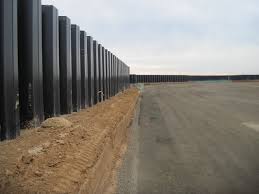
Fig 8: Sheet Pile Retaining Wall
Courtesy: strongwell.com
Sheet pile retaining walls are made up of interconnected piles driven into the foundation soil individually. Modern sheet piles are steel, wood, or precast concrete parts, among other materials. The active and passive stresses acting on the lower half of a Cantilever sheet pile wall can sometimes hold it in place.
9. Anchored Retaining Wall:
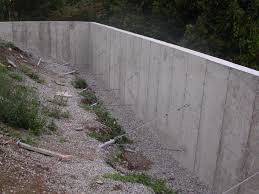
Fig 9: Anchored Retaining Wall
Courtesy: buchheitconcrete.com
An anchor into the soil, rock or other resistant material is used in anchored retaining walls to resist active soil pressure forces. The forces required to prevent overturning and sliding are provided by these anchors. Because the anchors are loaded axially, they can resist higher loads and are a good use of material, especially since the concrete stem won’t need to be as thick. They’re also highly robust and resistant to higher forces when there’s less room to work with, so you’ll see them on construction sites where nearby buildings are a worry.
10. Diaphragm Retaining Wall:
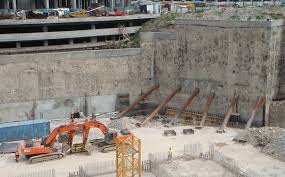
Fig 10: Diaphragm Retaining Wall
Courtesy: designingbuildings.com
Reinforced concrete or sheet pile walls can be used as diaphragm walls. It consists of a fixed vertical concrete reinforced concrete slab. The passive and active pressures operating on the lower half of the wall keep it in place.
Advantages of Retaining Wall:
- You can secure your building by constructing a retaining wall.
- When your structure is placed in a sloping environment, retaining walls are intended to resist and combat side gravity. In such a location, landslides and erosion can be avoided.
- Retaining walls are a practical solution for preventing sinkholes from damaging your landscaping. They are used to provide level surfaces on slopes and stabilize sloping landscapes.
- The landscape area can be protected with a retaining wall. As a result, maintenance can be minimized over time.
- Retaining walls can contribute to the aesthetic value of your environment.
Disadvantages of Retaining Wall:
- Due to severe pressure or drastic temperature changes, certain retaining walls develop vertical fissures in the poured concrete.
- Some retaining walls, such as brick walls, cannot withstand severe soil pressure, resulting in brick breakage or foundation failure.
- When wood is utilized as a retaining wall, termites may be attracted to your property.
Conclusion
Retaining walls are primarily used to prevent soil erosion, create usable beds from steep terrain, and provide decorative or functional landscaping features. They can be self-contained structures or part of a larger construction project, such as a building. Planning clearance is required if the wall is above 1-meter high near a road or pathway or over 2-meters high elsewhere. Building regulations may not be required for independent, freestanding retaining walls; however, all constructions must be structurally sound and well maintained.
References
1. Retaining wall design and its types used on construction. (2020, March 5). Constro Facilitator; www.constrofacilitator.com. https://www.constrofacilitator.com/retaining-wall-design-and-its-types-used-on-construction/
2. 9 Types of Retaining walls and Uses, Advantages of Retaining wall. (2020, September 18). Civil Knowledges; www.civilknowledges.com. https://www.civilknowledges.com/9-types-of-retaining-walls/
3. What is Retaining Wall? – Types of Retaining Walls – Civil Engineering. (n.d.). What Is Retaining Wall? – Types of Retaining Walls – Civil Engineering; civiltoday.com. Retrieved April 9, 2022, from https://civiltoday.com/construction/wall/249-retaining-wall-definition-types-materials
4. What Is Retaining Walls? | Uses of Retaining Wall | Types of Retaining Wall | Advantages of Retaining Wall. (2022, April 1). 9To5Civil; 9to5civil.com. https://9to5civil.com/types-of-retaining-wall/
5. Retaining Wall: Types, Purpose, Advantages & Disadvantages. (2020, April 17). Constructionor.Com; constructionor.com. https://constructionor.com/retaining-wall/
6. Mahajan, B. (2019, November 20). 10 Types Of Retaining Wall | What Is A Retaining Wall | Gravity Retaining Wall | Retaining Wall Design. Civiconcepts; civiconcepts.com. https://civiconcepts.com/blog/retaining-wall
7. What is a Retaining wall? | 12 Types of Retaining Wall | Importance, Advantages & Disadvantages. (2021, September 6). Dream Civil; dreamcivil.com. https://dreamcivil.com/retaining-wall/
If you have a query, you can ask a question here.


